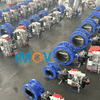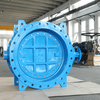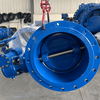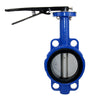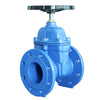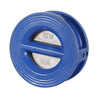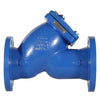Multi-Standard vs Regular Gate Valves: Key Differences
A multi-standard gate valve is a specially designed industrial valve engineered to comply with two or more international or industry standards. Its primary purpose is to enable seamless integration across different pipeline systems—offering a “one-valve-fits-many” solution. This makes it particularly suitable for international projects, export-oriented applications, and systems involving mixed standards.
Key features include:
- Flange dimensions and bolt patterns compatible with multiple standards
- Structural and performance specifications that meet various standard requirements
- Greater flexibility for use in global engineering projects and multi-standard environments.
Design Concept and Technical Features
1.Flange Compatibility Design
The flange face is engineered to accommodate multiple international standards, such as:
ANSI B16.5 /Class 150
DIN EN 1092-1 /PN10/16
Flange drilling can be configured with multiple bolt patterns or elliptical holes, allowing a single valve to connect with pipeline systems from different countries.
2. Cross-Standard Nominal Size and Pressure Rating
For example, a nominal diameter of DN100 corresponds to:
NPS 4” under ANSI standards
DN100 under DIN/GB standards
Multi-standard gate valves are typically designed to support both dimensions, ensuring compatibility across systems.
3. Optimized Face-to-Face Length
The structural (face-to-face) length of the valve is often chosen as a balanced or intermediate value, enabling compatibility between different standards.
4. Multi-Standard Markings on Valve Body
Valve bodies are usually marked with multiple standard references, such as:
“DN100 / NPS 4”
“PN16 / Class 150”
“EN / ANSI / GB Compatible”
5. Cross-Standard Materials and Testing
Materials can comply with multiple international standards like ASTM, EN, or GB.
Testing protocols—such as pressure and sealing tests—can follow combined standards, for example: API 598 + GB/T 13927.
Detailed Comparison with Regular Gate Valves
|
Comparison Aspect |
Multi-Standard Gate Valve |
Regular Gate Valve |
|
Compatibility |
Compatible with multiple global standards; ideal for export and international projects |
Supports only a single standard |
|
Flange Design |
Multi-standard flange drilling (e.g., ANSI + DIN + GB) |
Fixed flange drilling; matches only one standard |
|
Inventory Management |
One model fits various systems, reducing inventory burden |
Multiple standards require multiple models, increasing inventory load |
|
Installation Flexibility |
Easily matches regional equipment without valve replacement |
Valve must be replaced when switching systems or standards |
|
Manufacturing Complexity |
More complex design and processing; slightly higher cost |
Mature design and simpler manufacturing |
|
Markings |
Multi-standard markings for global identification |
Typically marked with only one standard |
|
Price |
Generally more expensive |
More affordable |
Is a Gate Valve Marked Only with PN10/PN16 Considered Multi-Standard?
If a gate valve body is marked with both PN10 and PN16—but without other standards such as Class (ANSI) or NPS—it is classified as a dual-pressure valve within the European (EN) standard system, not a true multi-standard gate valve that spans different systems like ANSI or GB.
Its core value lies in extending compatibility within a single standard family, specifically by covering both 10-bar and 16-bar pressure systems under the EN framework.

Fundamental Differences Between PN10/16 Valves and True Multi-Standard Gate Valves
|
Feature |
PN10/PN16 General Gate Valve |
Multi-Standard Gate Valve (e.g., PN16 / Class 150) |
|
Standards Compatibility |
Limited to European (EN) standards |
Cross-compatible with EN, ANSI, and GB standards |
|
Flange Design |
Fixed EN 1092-1 bolt pattern |
Elliptical or multi-pattern design for EN + ANSI + GB |
|
Pressure Range Logic |
Covers multiple pressures within the same standard (PN10 → PN16) |
Maps pressure ratings across different systems (PN16 ↔ Class 150) |
|
Global Applicability |
Suitable only for EN-standard systems |
Ideal for mixed-standard or multi-country export projects |
Can a PN10/PN16 Valve Be Used with CLASS Standard Systems?
Gate valves marked only with PN10/PN16—without any Class designation—are strictly built to European (EN) standards and cannot be directly used in ANSI CLASS-based pipeline systems.
Here are the main reasons:
-
Flange Dimension Mismatch:
EN standard flanges follow EN 1092-1, while ANSI CLASS systems follow ASME B16.5. The bolt hole patterns differ and cannot be aligned. -
Different Pressure Rating Logic:
PN ratings are based on working pressure at room temperature (~20°C), whereas CLASS ratings are defined by pressure resistance at elevated temperatures (up to 425°C). The two are not directly interchangeable. -
Structural Length Differences:
EN-standard valves typically follow EN 558 (shorter face-to-face length), while ANSI CLASS valves follow API 600 or ASME B16.10, which are longer. The difference makes direct replacement or connection impossible in many cases.

Advantages of PN10/PN16 General Gate Valves
-
Dual Compatibility with Strong Versatility
Fully compatible with both PN10 and PN16 flange systems—no need to distinguish between pressure classes during selection or installation. -
Reduced Inventory Pressure
A single model covers two mainstream pressure levels, simplifying inventory management and purchasing processes. -
Improved On-Site Efficiency
If project drawings change or system pressure needs to be adjusted, the valve does not need to be replaced—offering greater flexibility during construction. -
Standardized Manufacturing with Reliable Quality
Typically made with high-strength materials such as QT500-7, these valves meet PN16 working conditions and ensure long-term durability and safety. -
Advanced Structural Design
Multi-hole flange configurations are available, and some designs even support Class 125/150 bolt patterns, making them both practical and widely compatible. -
Enhanced User Experience
Buyers no longer need to worry about matching pressure classes or flange standards. One model solves multiple compatibility issues with ease.
Conclusion
With their wide compatibility and structural advantages, multi-standard gate valves are rapidly becoming the preferred solution for international projects and systems involving mixed standards. Compared to traditional valves, they offer greater flexibility in design, installation, inventory management, and long-term maintenance.
If you're looking for a gate valve that supports multiple international standards, delivers stable performance, and adapts easily to varied requirements, Union Valve is your trusted partner. With extensive experience in global projects, we are committed to providing high-quality, multi-standard compatible valve solutions to help your engineering operations run faster, smoother, and more reliably.
Feel free to contact us anytime for tailored recommendations and expert technical support.
Related Articles:
- How to Choose Between Flanged and Socket Weld Gate Valves for Industrial Pipelines
- Gate and Check Valves: Clear Comparison Guide
- Why Gate Valves Leak and How to Fix It
- What Is The Difference Between Wedge-Type Gate Valve And Slab Gate Valve?
- Characteristics of Resilient Seated Gate Valve and Their Differences from Metal Sealing Gate Valves
